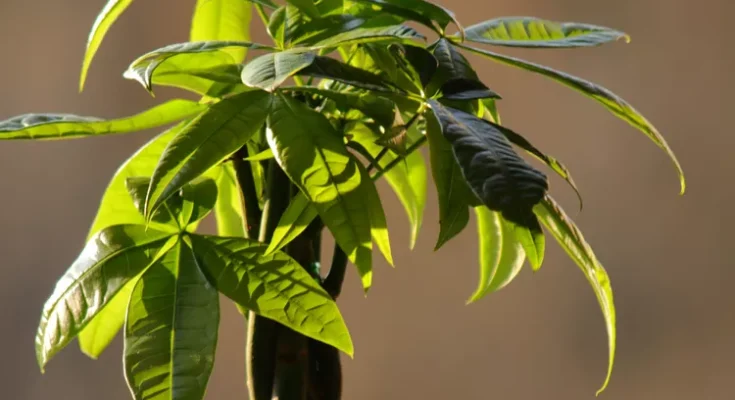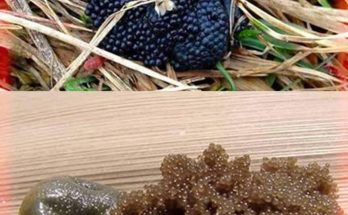The money tree plant (Pachira aquatica) is a foliage foliage houseplant typically made up of three to five plants braided together to form one plant. The glossy green foliage at the top of the plant consists of palmately compound leaves, usually five narrow leaflets. The plant is said to bring good fortune and prosperity.
The money tree plant is the houseplant form of a tropical tree that grows to 60 feet in the wild. Native to Central and South America, the tree blooms beautiful, large yellow flowers and produces edible brown nuts. Hence the common names for the tree are Malabar chestnut, Guiana chestnut, Saba nut, and French peanut.
In the wild, the trunks are not braided. As a houseplant, the plant’s young, immature stems are flexible enough to be able to braid three to five plants together. These young stems are held in place with string until they mature and become woody. Braiding is done by nurserymen but there are unbraided forms of the houseplant plus braided and unbraided bonsai forms.
Usually, houseplants are only a few feet tall, but they grow quickly whether indoors or out, up to 24 inches a year, and can grow up to 6 feet tall. Indoors, the money tree plant does not flower or produce nuts. It is known for its symbolism in Asian cultures. The plant is said to bring good luck, financial success, and prosperity. It is also said that it brings positive energy or “chi” in Feng Shui. It is the perfect gift to give to people starting a business, purchasing new homes, and to celebrate a new year.
Plant Attributes
| Common Name | Money tree plant, money plant |
| Botanical Name | Pachira aquatica |
| Family | Malvaceae |
| Plant Type | Tropical foliage houseplant |
| Mature Size | 6 ft. tall and 2 ft. wide |
| Sun Exposure | Partial |
| Soil Type | Well-drained loamy soil |
| Soil pH | Neutral to acidic |
| Bloom Time | Does not bloom indoors |
| Hardiness Zones | 10 (USDA) |
| Native Area | Central and South America |
Money Tree Plant Care
Grown like other tropical foliage plants, the money tree plant needs bright, indirect light and high humidity. It should be in a container with drainage holes and a loose, well-aerated potting mix. It does not need to be watered often; water when the top 2 inches are dry. It is best to increase the humidity as much as possible as houses are often dry inside
Fertilize with a liquid houseplant fertilizer in the summer. As it grows, if you want to keep the braided appearance, you have to braid the new stems and hold in place with string until those stems become woody and the braid holds. The only pruning it will need is to remove old or diseased leaves.
Light
This plant likes bright, indirect light.
Soil
Give money plant well-drained, loamy potting mix that is neutral to acidic. You may use a cactus or succulent specialty mix.
Water
Water when the top 2 inches of soil are dry. Make sure excess water drains out of the container.
Temperature and Humidity
This plant prefers warm temperatures, about 70 degrees, and at least 50% humidity. Especially in winter, you may have to increase humidity in the house by placing the container on a tray of pebbles in water or by misting the plant with water.
Fertilizer
Fertilize with a foliage houseplant fertilizer during the growing season.
Pruning
The money tree plant will only need pruning to remove dead or diseased foliage. However, as the plant grows, it will have to be continued to be braided to keep the appearance. Keep the braid tied together with string until the stem becomes woody so it will stay in place.
Propagating Money Tree Plants
The money tree plant can be propagated by stem cuttings or by seed. Seed will take longer to get a mature houseplant. To have a braided plant, you need at least three plants. During the growing season, when you see new growth on the plant, propagate by taking a stem cutting.
How To Propagate From Stem Cuttings
- Use a sterilized, razor-sharp knife or razor blade to cut the top 5 inches of the stem with at least two nodes. Cut right below the node, which is where the leaves are attached to the stem. There is a higher chance of rooting if you cut below the node.
- Insert the bottom end into water, shake it off, dip the end into a powder rooting hormone, and then plant in a small plastic container with drainage holes that’s filled with seed-starting mix. (You can cut off the base of a gallon milk jug and make drainage holes. It is best to do one cutting per small 2-inch container, two cuttings per 4-inch container, or several per milk jug.)
- Poke holes into the already moistened growing medium with a pencil. Insert the cutting so the stem is a few inches deep to be able to stand up.
- Cover with a plastic bag so the bag is “inflated.” Either blow in the bag and seal or prop up with wire hangers. The size of the bag and how it will stay inflated will depend on the size of the container.
- What you are creating for these cuttings is a mini greenhouse so the cuttings can root without losing too much moisture. There should be condensation on the inside of the bag. This indicates sufficient moisture to keep the plant turgid.
- Place these mini greenhouses in an area that is 60°F to 75°F. If they are outside, place in the shade. If inside, set them in either a northern exposure window or under fluorescent lights for 16 hours per day.
- It will take four to 8 weeks for roots to develop. When the cuttings have rooted, gradually open the plastic, a few hours a day, to acclimate the plant. Eventually, when it does not wilt with the bag opened, pot up into a larger container and let it grow in a cold frame or greenhouse until you can plant outside the next season.
How To Grow Money Tree Plant From Seed
- For each seed, have a clean, plastic container with drainage holes, about 6 inches wide.
- Fill a container with seed-starting mix or a well-draining potting mix and water to saturate.
- The seeds are large so plant one seed per container, about ¼ inch deep, and then water again.
- Place containers on a tray in a warm area with bright, indirect light.
- Water when the top inch of soil dries out.
- As the seed germinates and you see growth, you may be able to water a little less.
- Continue to grow in the container in bright, indirect light.
- As the plant grows, you may have to repot into a larger container. If you want to braid the plant, you will need a container large enough for at least three plants.
Potting and Repotting
As the money tree plant grows, it may need repotting. The plant itself has shallow roots and may not get very wide, but as it gets taller, it may need more support from the base so it does not topple over. Purchase a container that is about 2 inches larger than the existing container, with drainage holes. Overturn the existing plant and gently pull the plant from the container. Tease out the roots so they are not compacted. Repot into a new container with new potting mix. Tamp down and plant just about an inch below the rim so the water does not spill out when you water the plant. After repotting, check to see if you need a larger tray. Water the plant.
Overwintering
Because the money tree plant is grown as a foliage houseplant indoors, it requires minimal changes in the winter. Do not fertilize the plant and water less frequently. If possible, increase efforts to increase humidity as the air often is too dry in the winter.
Common Pests & Plant Disease
Like other foliage houseplants, money tree plants may be attacked by spider mites, aphids, mealybugs, and fungus gnats. To control spider mites and aphids, spray the plant with insecticidal soap. Mealybugs can be removed by wiping them off with a cotton swab dipped in alcohol. Fungus gnats indicate overwatering and can be deterred by less watering as well as applying about ½ inch of horticultural sand on top of the potting mix.
Diseases include leaf spots and root rot. Leaf spots may be caused by anthracnose, a fungal disease that damages the foliage. Remove the affected foliage. When watering, do not get water on the leaves and cut down on the misting. If the problem is severe, consider spraying with a copper fungicide.
Root rot is often caused by watering too much and is a fungal issue that destroys the roots. Water less and consider repotting to a better mix in case your mix is not aerated or does not drain fast enough.
Common Problems With Money Tree Plant
The money tree plant is an easy-to-grow houseplant. However, plant owners may overwater or underwater plants until they get the hang of it, or they may not be able to provide enough light and humidity. If the plant is not getting what it needs, it will tell you.
Leaves Turning Yellow
This can be caused by dry air, in which case you need to increase the humidity. It can also be caused by overwatering. Check the soil for moisture. It needs to be watered when the top two inches of soil are dry. Make sure the soil has good drainage.
Leaves Turning Brown
Crisp, brown leaves can be caused by underwatering, in which case you either must water more frequently or thoroughly (so it runs out of the drainage holes). This can also be caused by dry air. Try to increase the humidity by placing the plant on a tray with water and pebbles and misting the plant.
Drooping Leaves
If green leaves are drooping, this can be a sign that the plant is not getting enough water (the plant is wilted) or too much water (the soil is saturated and the plant cannot obtain oxygen in the soil). If the soil also is dry, you have underwatered. If the soil is wet, then you are watering too much or too frequently.
Leaning Plant
If the plant is leaning to one side, it needs more light. If more light cannot be given, rotate the plant often so will grow symmetrically, as plants tend to lean toward a light source when it is insufficient.



